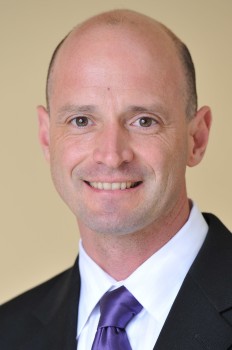Ten Questions: J.R. DeShazo and solar power J.R. DeShazo explains how solar can provide up to a third of L.A.'s energy, without costing a bundle
by Alison Hewitt
Environmental economist J.R. DeShazo’s recent research is the basis of Los Angeles’ new solar power policy. DeShazo explains how solar can provide up to a third of L.A.’s energy, without costing a bundle.
J.R. DeShazo, the director of The UCLA School of Public Affairs Luskin Center for Innovation and an associate professor of public policy, describes himself as an

environmental economist. Most recently, he turned his focus to how Los Angeles can create policies that will encourage Angelenos to turn their rooftops into a glittering sea of solar panels. His research formed the basis of L.A.’s new solar plan. DeShazo sat down with UCLA Today writer Alison Hewitt to explain how solar could save L.A. Below is an edited Q&A.
Why bother with solar energy?
Solar power is completely underutilized in Los Angeles. All the unused capacity – on business rooftops, on top of parking lots, in fields – adds up to 5.5 gigawatts, which could meet about a third of L.A.’s energy needs. California is a leader in solar, thanks to state and federal subsidies, but Los Angeles’ Department of Water and Power still gets 44 percent of its energy from coal. That’s a lot for California.
So why haven’t more rooftops begun sprouting solar panels already?
The biggest obstacle to increasing the availability of solar energy right now is the cost of solar panels. They’re still really expensive. The price is beginning to fall, but for now, government incentives are vital to make the cost of solar panels pan out.
Your solution is a program called feed-in tariffs, which would raise utility rates a little bit so the city could create a solar fund. The fund would help volunteers afford solar panels, and actually hook them up to the grid so that we could all use the power they generate. Is this a new program?
Variations on feed-in tariffs are being used around the world, from Japan and Spain to Florida and Vermont. Germany’s feed-in tariff program is the best known. But when I studied these other programs, it was discouraging. No one else’s policy was right for Los Angeles. They were all too expensive.
How did you design a solar feed-in tariff program that would be affordable?
One big change from other programs is that we have to target commercial customers, not residential customers.
What makes commercial buildings better?
Businesses have larger rooftops and parking lots where you can install large banks of solar panels. Existing feed-in tariff programs have focused on residential rooftops, but you miss all the economies of scale that way. Federal tax subsidies can help reduce the cost, but only if you’re already paying a lot of taxes, as a company would. We want to include homeowners, nonprofits, schools and hospitals, but commercial properties have to be the main target.
Why would companies want to enter the solar power business and sell clean energy to the city?
Because the feed-in tariff system would provide a “reasonable rate of return” – a small profit. Solar power is still too expensive to pan out economically for most people, but if we buy it from feed-in tariff providers the same way we buy it from utility companies, they can make their money back. The city would buy the solar power for a slightly above-market rate using its solar fund.
Why would residents agree to pay a little more for power just so their neighbors or local companies could earn a profit selling them solar power?
Solar is the only renewable energy program that produces jobs in L.A. Wind farms will be elsewhere. Geothermal energy sources are far away. But we have a massive amount of unused solar capacity right here in Los Angeles.
We’re also known as the nation’s most polluted city. A solar power program can change the way we’re perceived and how Los Angeles thinks about itself. Los Angeles has very ambitious renewable energy targets, but we’re struggling to meet them. This plan was designed to help Los Angeles meet its renewable energy goals with the lowest possible impact to ratepayers.
How is your research being used by Los Angeles?
The details are still being negotiated at City Hall, but the mayor is using our research as the basis for his solar policy.
How could the energy landscape change if solar becomes as widespread as you hope?
This could change everything. So many people will have solar that we won’t need the Department of Water and Power – well, except on rainy days. There will be a big shift from energy delivery to energy reliability. Actually, it threatens power utilities’ business model, which is centered on production and transmission, not on distribution from sources all over the city. Power generation would become a public-private partnership.
What made you decide to research solar power policy?
The Luskin Center’s focus for our first three years is on environmental sustainability. Our mission is solving regional problems, local problems where we can have the biggest impact. We identify problems that need to be solved and look for a partner, like the City of Los Angeles, who can benefit from our research.

Leave a Reply
Want to join the discussion?Feel free to contribute!